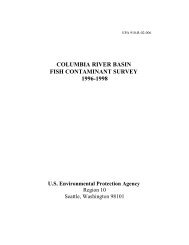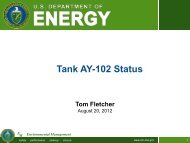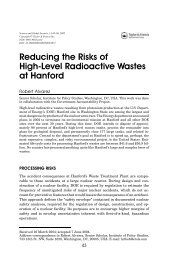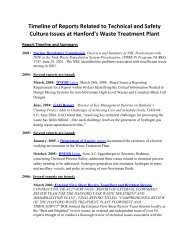Knowing Endangerment - Hanford Challenge
Knowing Endangerment - Hanford Challenge
Knowing Endangerment - Hanford Challenge
You also want an ePaper? Increase the reach of your titles
YUMPU automatically turns print PDFs into web optimized ePapers that Google loves.
CHG‟s monitoring equipment has limited capabilities to detect hazards in the workplace<br />
environment, especially since many of the chemicals in the vapors are unknown and uncharacterized.<br />
Most of the sampling that has occurred on the tank headspaces is over seven years old. 47 Very little<br />
characterization of vapor space monitoring has occurred since the recent “accelerated cleanup”<br />
activities began. Only 11 tank headspaces have been sampled since 1999, and none of those<br />
occurred in 2002 or 2003. 48 As retrieval operations disturb and change the chemical constituents in<br />
the tank, monitoring of tank vapors must be revised and readjusted to reflect what is really in the<br />
tanks. One senior industrial hygienist for CHG recently admitted that there are unknown chemicals<br />
and compounds emitted from the tanks that cannot be tested for with CHG‟s monitoring equipment. 49<br />
Even if all the chemicals coming off the tanks are identified and characterized, most of CHG‟s air<br />
monitoring instruments can detect only a handful of compounds at one time, out of potentially 1200<br />
chemicals present in the vapors. 50 The instruments can only be calibrated to a few compounds at a<br />
time and within a certain range (see Appendix C).<br />
There are additional technical problems with the equipment. For example, CHG‟s recently acquired<br />
RAE Systems parts-per-billion photo-ionization organics monitor (ppbRAE) was found to have such<br />
“poor performance” in tests for agent sensitivity that the U.S. Army discontinued testing of this<br />
detector‟s ability to detect the presence of certain organic chemicals; specifically, airborne chemical<br />
weapons. 51 The ppbRAE had reduced sensitivity with increasing use, as the UV lamps used to ionize<br />
the vapor samples for detection were easily contaminated by dust, dirt, moisture, and other exposure<br />
residue. Frequent and thorough cleaning was needed to maintain detector performance. The report<br />
questioned the reliability of the ppbRAE, citing among other things, the need for frequent recalibration,<br />
the wide range of response factors observed, and its inability to detect some tested<br />
chemicals even at IDLH levels. 52<br />
Prior to acquiring the ppbRAE, CHG used the “580-EZ” to perform much lower explosive limit<br />
(LEL) and total organic compounds (TOC) 53 monitoring until late 2002. 54 The 580-EZ was<br />
manufactured to detect a few specific TOCs as well as ammonia. However, this instrument is known<br />
47 See TWINS database, supra note 10.<br />
48 May 6, 2003 letter from Mary Beth Burandt, DOE-RL, to Clare Gilbert, Government Accountability Project,<br />
responding to a request for information on tank waste characterization. 03-ORP-049.<br />
49 [Industrial Hygiene] Senior Safety Manager, CH2M Hill <strong>Hanford</strong> Group, Sworn Deposition in connection with<br />
Stone, et. al. v. CH2M Hill <strong>Hanford</strong> Group, filed with the Department of Labor, May 7, 2003, pg. 62 [hereinafter IH<br />
Deposition].<br />
50 L.M. Stock & J.L. Huckaby, supra note 10.<br />
51 Teri Longworth and Kwok Y. Ong, United States Army, Soldier and Biological Chemical Command, DOMESTIC<br />
PREPAREDNESS PROGRAM: TESTING OF RAE SYSTEMS PPBRAE VOLATILE ORGANIC COMPOUND (VOC) MONITOR<br />
PHOTO-IONIZATION DETECTOR (PID) AGAINST CHEMICAL WARFARE AGENTS, SUMMARY REPORT, ECBC-TR,<br />
September 2001, pg. 16, available at http://www2.sbccom.army.mil/hld/downloads/reports/ppbrae_final.pdf<br />
52 Id. at 12-16.<br />
53 GAP has consulted several representatives from various companies that manufacture and sell monitoring<br />
equipment used by CHG, and very few seem to know what TOC stands for. CHG asserts that it stands for Total<br />
Organic Compounds. Some company representatives assert that it stands for Total Organic Carbons. Still other<br />
experts assert that it stands for Toxic Organic Compounds. For purposes of this report, GAP assumes it means<br />
“Total Organic Compounds,” though what exactly that entails, we are still not sure.<br />
54 CHG still relied on the 580-EZ as of December 2002, although less frequently than in previous months. Most<br />
CHG DRI surveys for 2002 list the 580 EZ as the instrument used in its TOC monitoring surveys.<br />
14







